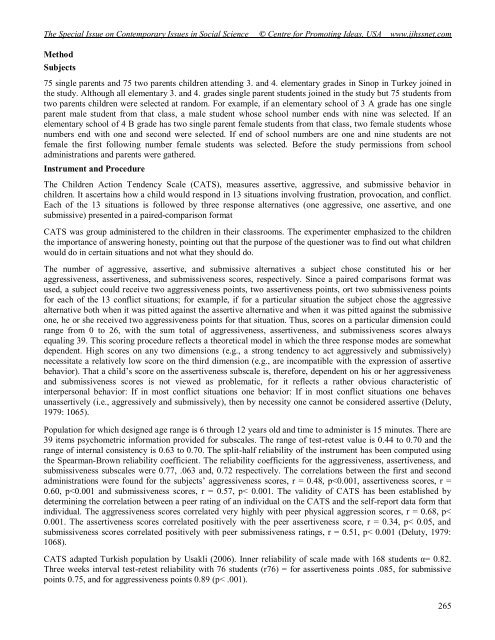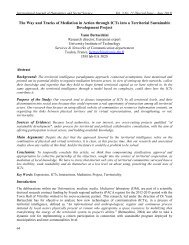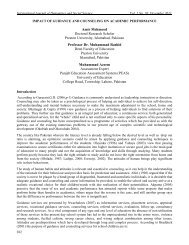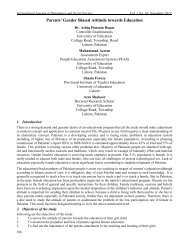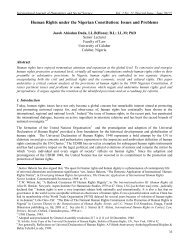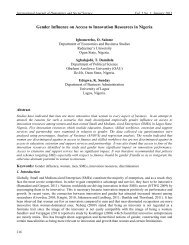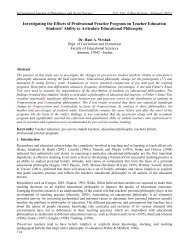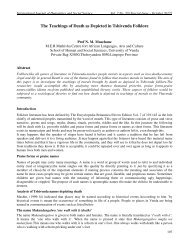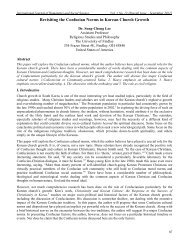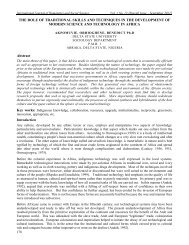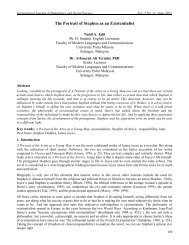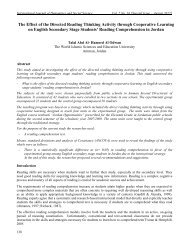Comparison of Single and Two Parents Children in terms of ...
Comparison of Single and Two Parents Children in terms of ...
Comparison of Single and Two Parents Children in terms of ...
You also want an ePaper? Increase the reach of your titles
YUMPU automatically turns print PDFs into web optimized ePapers that Google loves.
The Special Issue on Contemporary Issues <strong>in</strong> Social Science<br />
© Centre for Promot<strong>in</strong>g Ideas, USA www.ijhssnet.com<br />
Method<br />
Subjects<br />
75 s<strong>in</strong>gle parents <strong>and</strong> 75 two parents children attend<strong>in</strong>g 3. <strong>and</strong> 4. elementary grades <strong>in</strong> S<strong>in</strong>op <strong>in</strong> Turkey jo<strong>in</strong>ed <strong>in</strong><br />
the study. Although all elementary 3. <strong>and</strong> 4. grades s<strong>in</strong>gle parent students jo<strong>in</strong>ed <strong>in</strong> the study but 75 students from<br />
two parents children were selected at r<strong>and</strong>om. For example, if an elementary school <strong>of</strong> 3 A grade has one s<strong>in</strong>gle<br />
parent male student from that class, a male student whose school number ends with n<strong>in</strong>e was selected. If an<br />
elementary school <strong>of</strong> 4 B grade has two s<strong>in</strong>gle parent female students from that class, two female students whose<br />
numbers end with one <strong>and</strong> second were selected. If end <strong>of</strong> school numbers are one <strong>and</strong> n<strong>in</strong>e students are not<br />
female the first follow<strong>in</strong>g number female students was selected. Before the study permissions from school<br />
adm<strong>in</strong>istrations <strong>and</strong> parents were gathered.<br />
Instrument <strong>and</strong> Procedure<br />
The <strong>Children</strong> Action Tendency Scale (CATS), measures assertive, aggressive, <strong>and</strong> submissive behavior <strong>in</strong><br />
children. It ascerta<strong>in</strong>s how a child would respond <strong>in</strong> 13 situations <strong>in</strong>volv<strong>in</strong>g frustration, provocation, <strong>and</strong> conflict.<br />
Each <strong>of</strong> the 13 situations is followed by three response alternatives (one aggressive, one assertive, <strong>and</strong> one<br />
submissive) presented <strong>in</strong> a paired-comparison format<br />
CATS was group adm<strong>in</strong>istered to the children <strong>in</strong> their classrooms. The experimenter emphasized to the children<br />
the importance <strong>of</strong> answer<strong>in</strong>g honesty, po<strong>in</strong>t<strong>in</strong>g out that the purpose <strong>of</strong> the questioner was to f<strong>in</strong>d out what children<br />
would do <strong>in</strong> certa<strong>in</strong> situations <strong>and</strong> not what they should do.<br />
The number <strong>of</strong> aggressive, assertive, <strong>and</strong> submissive alternatives a subject chose constituted his or her<br />
aggressiveness, assertiveness, <strong>and</strong> submissiveness scores, respectively. S<strong>in</strong>ce a paired comparisons format was<br />
used, a subject could receive two aggressiveness po<strong>in</strong>ts, two assertiveness po<strong>in</strong>ts, ort two submissiveness po<strong>in</strong>ts<br />
for each <strong>of</strong> the 13 conflict situations; for example, if for a particular situation the subject chose the aggressive<br />
alternative both when it was pitted aga<strong>in</strong>st the assertive alternative <strong>and</strong> when it was pitted aga<strong>in</strong>st the submissive<br />
one, he or she received two aggressiveness po<strong>in</strong>ts for that situation. Thus, scores on a particular dimension could<br />
range from 0 to 26, with the sum total <strong>of</strong> aggressiveness, assertiveness, <strong>and</strong> submissiveness scores always<br />
equal<strong>in</strong>g 39. This scor<strong>in</strong>g procedure reflects a theoretical model <strong>in</strong> which the three response modes are somewhat<br />
dependent. High scores on any two dimensions (e.g., a strong tendency to act aggressively <strong>and</strong> submissively)<br />
necessitate a relatively low score on the third dimension (e.g., are <strong>in</strong>compatible with the expression <strong>of</strong> assertive<br />
behavior). That a child‟s score on the assertiveness subscale is, therefore, dependent on his or her aggressiveness<br />
<strong>and</strong> submissiveness scores is not viewed as problematic, for it reflects a rather obvious characteristic <strong>of</strong><br />
<strong>in</strong>terpersonal behavior: If <strong>in</strong> most conflict situations one behavior: If <strong>in</strong> most conflict situations one behaves<br />
unassertively (i.e., aggressively <strong>and</strong> submissively), then by necessity one cannot be considered assertive (Deluty,<br />
1979: 1065).<br />
Population for which designed age range is 6 through 12 years old <strong>and</strong> time to adm<strong>in</strong>ister is 15 m<strong>in</strong>utes. There are<br />
39 items psychometric <strong>in</strong>formation provided for subscales. The range <strong>of</strong> test-retest value is 0.44 to 0.70 <strong>and</strong> the<br />
range <strong>of</strong> <strong>in</strong>ternal consistency is 0.63 to 0.70. The split-half reliability <strong>of</strong> the <strong>in</strong>strument has been computed us<strong>in</strong>g<br />
the Spearman-Brown reliability coefficient. The reliability coefficients for the aggressiveness, assertiveness, <strong>and</strong><br />
submissiveness subscales were 0.77, .063 <strong>and</strong>, 0.72 respectively. The correlations between the first <strong>and</strong> second<br />
adm<strong>in</strong>istrations were found for the subjects‟ aggressiveness scores, r = 0.48, p


